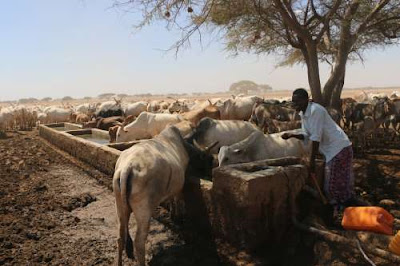By Sophie Mbugua, BRACED
YAMICHA, Kenya - Gusts of
wind blow the dust coming from thousands of animals as they make their way to
Urura borehole in Kenya's arid northern Merti ward.
The well is set in a
grazing area reserved for use only during severe drought periods. This dry
month, about 3,000 cows, 12,000 goats and 1,800 donkeys access the strategic
water reserve every day.
Abdi Matoiye from Biligi
village and his 100 cows have walked for about 20 kilometres (12 miles) to get
here - and it's not just the water that is the attraction.
Matoiye recently lost a
cow after it was bitten by wild dogs infected with rabies. Now he is worried
that the calf is showing signs of the disease too. Fortunately, a veterinarian
is available to answer this distress call.
 |
| Matoiye and his cattle drink at the Urura well in Kenya’s Isiolo County. TRF/Sohie Mbugua |
"A cow gets infected
by sniffing bites from the bitten cow," Matoiye believes. "We are
worried that more cows might die since we are sharing the grazing area and the
borehole."
Northern Kenya, an arid
region inhabited by nomadic pastoralists, is increasingly prone to droughts, a
problem that has depleted livestock, water and pasture. Migration during
drought periods exposes animals to diseases as they converge on remaining
grazing land and watering points.
And pasture and water
scarcity continue to be a key driving force for conflict between communities as
livestock and people move around the counties of Marsabit, Moyale, Garissa,
Isiolo and Wajir, locals say.
But a two-year effort to
bring together a range of adaptations to the worsening drought - including new
wells and other water sources, carefully managed grazing reserves and better
veterinary care - is helping pastoralists such as Matoiye manage drought better
and protect their animals, incomes and families.
Read the full story at Building
Resilience and Adaptation to Climate Extremes and Disasters (BRACED)
No comments:
Post a Comment